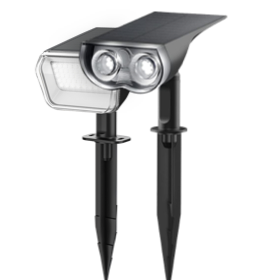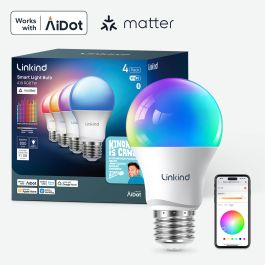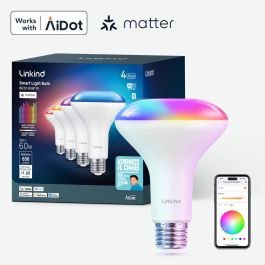Understanding the Differences: RGB vs. RGBIC vs. RGBW LED Strip Lights
Understanding the Differences: RGB vs. RGBIC vs. RGBW LED Strip Lights
LED strip lights have become a staple in modern lighting solutions, revolutionizing the way we illuminate our spaces. Whether it's adding a dash of ambiance to a cozy living room, accentuating architectural features, or setting the mood for a lively party, LED strip lights offer unparalleled versatility and energy efficiency. However, the abundance of options in the market can often leave consumers bewildered, particularly when it comes to deciphering the disparities between RGB, RGBIC, and RGBW LED strip lights. Each variant boasts its own unique features, advantages, and ideal use cases, making it imperative for consumers to grasp the nuances before making a purchase decision.
What are RGB LED Strip Lights?
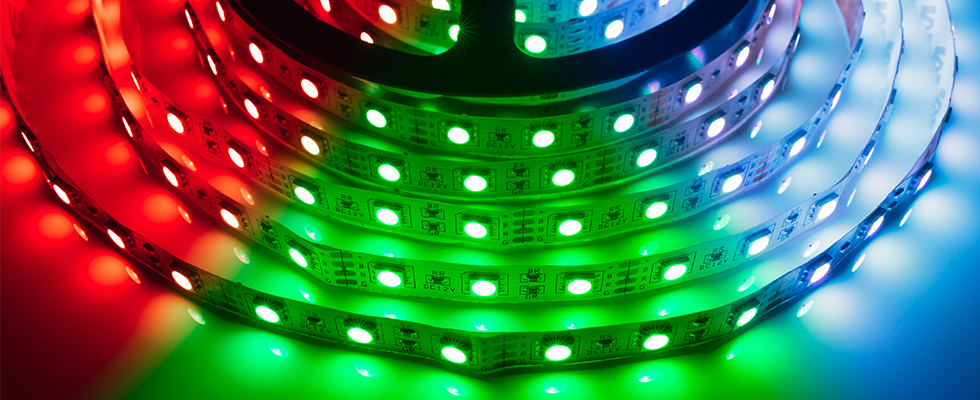
RGB LED strip lights, short for Red, Green, and Blue, employ a combination of these primary colors to generate a wide spectrum of hues. By adjusting the intensity of each color channel, RGB LED strips can produce virtually any shade imaginable, offering unparalleled flexibility in lighting design. This makes them an ideal choice for applications where dynamic and colorful lighting effects are desired, such as party decorations, gaming setups, and creative DIY projects. With their energy efficiency and extended lifespan, RGB LED strips have garnered popularity in both residential and commercial settings, serving as a versatile lighting solution for various needs.
What are RGBIC LED Strip Lights?
RGBIC LED strip lights, standing for Red, Green, Blue, Independent Control, represent a technological advancement over traditional RGB lighting. Unlike conventional RGB strips that change color uniformly across the entire length, RGBIC LED Strip Lights enable individual control of each LED segment. This breakthrough functionality empowers users to create intricate color patterns, gradients, and animations, elevating the lighting experience to new heights. Whether it's enhancing ambiance in home theaters, accentuating architectural elements, or crafting dynamic lighting scenes for events, RGBIC LED strip lights offer unparalleled versatility and creative freedom. Their ability to produce complex lighting effects makes them a preferred choice for those seeking to customize their lighting displays with precision and sophistication.
What are RGBW LED Strip Lights?

RGBW LED strip lights integrate an additional White LED alongside the standard Red, Green, and Blue LEDs, enhancing their versatility and color quality. By incorporating a dedicated White LED, RGBW strips can produce purer, brighter white light compared to the composite white generated by blending RGB LEDs. This feature makes RGBW LED Strip Lights ideal for applications requiring both colorful accent lighting and high-quality white illumination. Whether illuminating living spaces with vibrant hues or providing dependable white light for functional purposes, RGBW LED strip lights offer a comprehensive solution for diverse lighting requirements.
|
Types of LED Strip Lights |
Key Features |
Chip Technology |
Brightness |
Price Range |
Applications |
|
RGB |
Combines Red, Green, Blue to create a wide range of colors |
Basic RGB Chip |
Moderate |
$10-$30/meter |
Party decorations, gaming setups, DIY home projects, under-cabinet lighting, Interior Car Lights |
|
RGBIC |
Allows individual control of each LED segment for complex patterns |
Independent Control Chip |
High |
$20-$50/meter |
Advanced lighting effects, vibrant displays, car interiors, outdoor festive decorations |
|
RGBW |
Includes an additional White LED for purer white light |
RGB + White Chip |
Very High |
$30-$60/meter |
General lighting, ambient lighting, living rooms, kitchens, offices, TV back lights |
Note: Prices are indicative and can vary based on brand, quality, and specific product features.
How to Choose LED Strip Lights
Versatile Customization: Shape and mold into various shapes and designs with 16 million colors and 45 lighting presets for limitless creative possibilities. Seamless Control: Easily control your lighting using the AiDot app or voice commands via Alexa and Google Assistant, adjusting settings effortlessly. Vivid Brightness: Equipped with 84 LEDs per meter, providing 200 lumens for a bright, even glow that enhances any indoor space. Robust Construction: Made from high-quality silicone, this rope light offers flexibility and durability, ensuring easy shaping and long-lasting performance. Entertainment Sync:Integrate with AiDot TV Backlight and other AiDot devices to create synchronized light shows that enhance and extend your TV viewing experience.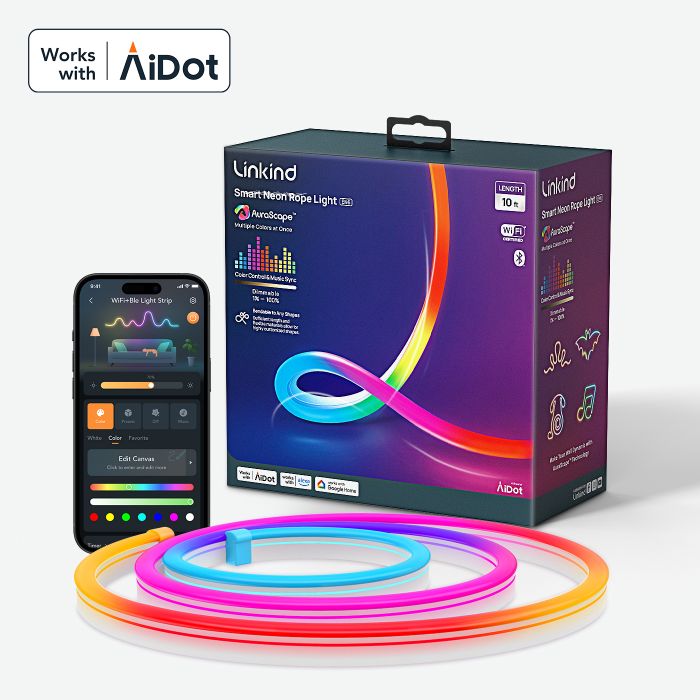
Selecting the right LED strip lights entails considering various factors beyond mere color preferences. For a comprehensive guide on selecting the optimal LED strip lights for your specific requirements, refer to our article "A Comprehensive Guide to Choosing LED Strip Lights."Here are some key aspects to contemplate:
1. Brightness Levels
The brightness of LED strip lights, measured in lumens, plays a pivotal role in determining the adequacy of illumination for different settings. Higher brightness levels are typically required for task-oriented areas like kitchens or workspaces, whereas lower levels suffice for accent lighting in recreational spaces. LED strips are available in a broad range of brightness, spanning from 200 to 800 lumens per meter normally, allowing users to tailor their lighting solutions to specific needs.
2. Color Rendering Index (CRI)
The Color Rendering Index (CRI) gauges the accuracy of a light source in rendering colors compared to natural light. Opting for LED strips with a high CRI (>90+) ensures that colors appear vivid and true to life, making them particularly suitable for areas where color accuracy is paramount, such as living rooms or studios.
3. Kelvin Temperature
Kelvin temperature dictates the color temperature of the emitted light, with lower values producing warmer, yellowish light, and higher values yielding cooler, bluish light. By selecting the appropriate color temperature, users can create ambiance that aligns with their preferences and the intended atmosphere of the space.
4. Compatibility with Controllers and Smart Home Systems
For those seeking to integrate LED strip lights into smart home systems or control them remotely, compatibility with popular controllers such as Amazon Alexa, Google Assistant, or Apple HomeKit is crucial. Ensuring seamless connectivity between the LED strips and existing smart home setups enhances convenience and facilitates effortless control over lighting configurations.
5. Energy Efficiency and Longevity
While LED strip lights are renowned for their energy efficiency and durability, the efficacy may vary across different models and brands. Prioritize products with favorable energy ratings and extended lifespans to maximize the return on investment and minimize maintenance costs over time.
How to Install LED Strip Lights
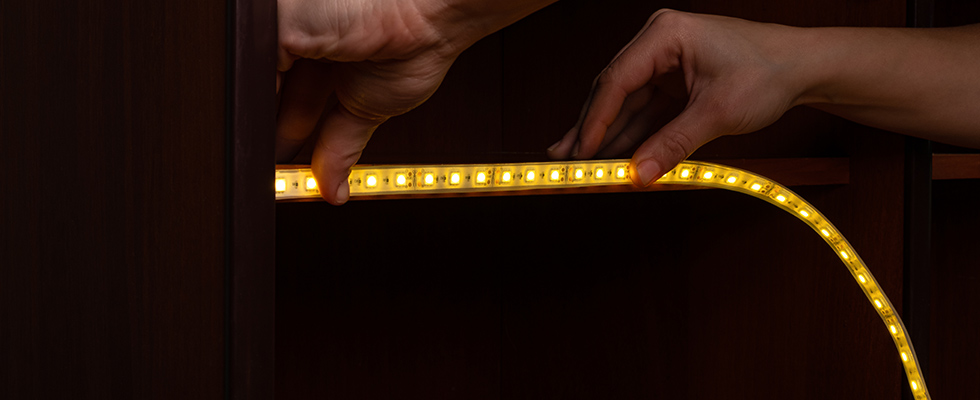
Achieving optimal results when installing LED strip lights demands meticulous planning and execution tailored to specific usage scenarios. Whether for automotive, indoor, or TV backlighting applications, adhering to professional installation guidelines ensures both safety and performance. Here's a comprehensive approach for each setting:
1. How to Install Car LED Strip Lights?
Precise Planning: Carefully evaluate your vehicle’s interior layout to determine the best placement for the LED strips. Strategic placement ensures both aesthetic appeal and functional illumination.
Surface Preparation: Prior to installation, meticulously clean and degrease the mounting surfaces using industry-grade cleaning agents. Remove any traces of dirt, oil, or residue to ensure optimal adhesion of the LED strips.
High-Quality Adhesive: Select LED strips equipped with automotive-grade adhesive backing, engineered to withstand the demanding conditions within vehicle interiors. Verify the adhesive's compatibility with various surfaces and ensure a secure bond for long-term durability.
Strategic Wiring: Exercise caution when routing wiring to avoid interference with moving parts or potential heat sources within the vehicle. Employ cable management solutions to secure wiring discreetly and minimize the risk of entanglement or damage.
Connecting the LED Strip Lights: Connect the power source to the controller box or wiring harness that comes with your LED strips. Ensure secure and properly insulated connections for safety and efficiency.
Tips:
1. Locate and Utilize the Fuse Box: Find the fuse box, typically located under the dashboard or in the engine compartment. Using the fuse box provides a stable power source for your car LED strip lights.
2. Utilize the Cigarette Lighter Port: Locate and use the cigarette lighter port for powering your LED strips. This method offers a convenient and accessible power source for your car LED strip lights.
3. Lay Out and Connect Strips: Lay out the LED strips and use the provided connectors to secure them. Proper connections ensure reliable performance and longevity of your car LED strip lights.
4. Mount Securely: Peel off a small section of the adhesive backing and press the strip firmly onto the prepared surface. Gradual application ensures a straight and secure installation.
5. Power On and Adjust: Turn on your LED strip lights and adjust the brightness as needed. Testing ensures everything is working correctly and provides the desired lighting effect.
6. Check for Issues: Inspect for any flickering or uneven lighting that could indicate a loose connection. Proper functioning confirms a successful installation of your car LED strip lights.
2. How to Install Indoor Room LED Strip Lights?
Planning and Measuring: Assess the room where you intend to install the LED strip lights. Measure the lengths needed and decide on the areas where the lights will have the most impact, such as under cabinets, along ceiling edges, or behind furniture for ambient lighting.
Surface Preparation: Clean the surfaces where the LED strips will be mounted. Use a mild cleaner to remove dust, grease, and other residues. Ensuring a clean surface will help the adhesive backings stick more effectively and last longer.
Choosing the Right LED Strips: Select LED strips that fit your lighting needs. Consider factors like brightness (lumens), color temperature (warm or cool), and whether you want color-changing options. Make sure to choose strips with a strong adhesive backing for better durability.
Installing the Strips: Begin by peeling off a small section of the adhesive backing and pressing the strip firmly onto the prepared surface. Gradually peel away the backing as you press the strip into place, ensuring it remains straight and secure.
Managing Cables: Use cable clips or holders to organize and secure the power cables. This not only creates a cleaner look but also prevents tripping hazards and potential damage to the wiring.
3. How to Install TV Backlighting?
Benefits of TV Backlighting: Adding LED strips behind your TV can reduce eye strain, enhance picture quality, and create an immersive viewing experience. It's a simple upgrade that makes a big difference.
Planning and Measuring: Measure the back of your TV to determine the length of LED strips needed. Consider a continuous loop around the edges for even lighting.
Surface Preparation: Just like with car and indoor room LED Strip Lights installations, cleaning the surface is vital. Wipe down the back of the TV with a gentle cleaner to remove dust and grime.
Installing the Strips: Peel off the adhesive backing and carefully stick the LED strips to the back of the TV, following your measured plan. Press firmly to ensure a good bond.
Managing Cables: Use cable clips or holders to manage the power cables neatly. This not only looks better but also prevents any accidental tugging or damage.
Conclusion
The choice between RGB, RGBIC, and RGBW LED strip lights hinges on a thorough understanding of individual preferences and lighting requirements. While RGB strips offer vibrant color displays, RGBIC strips provide advanced control for intricate patterns, and RGBW strips deliver both colorful accents and high-quality white illumination. By evaluating factors such as brightness
FAQs about LED Strip Lights
Q1: What is the main difference between RGB and RGBW LED strips?
A: The main difference is that RGBW strips include an additional White LED, which provides a purer and brighter white light compared to the white created by combining RGB LEDs.
Q2: Can I control RGBIC LED strips with a standard RGB controller?
A: No, RGBIC strips require a specialized controller that can manage the independent control of each LED segment.
Q3: Are LED strip lights energy-efficient?
A: Yes, LED strip lights are known for their energy efficiency and long lifespan, making them a cost-effective lighting solution.
Q4: How do I choose the right brightness level for my LED strip lights?
A: Consider the application and the amount of light needed. For task lighting, choose higher brightness levels, while for accent lighting, lower levels may suffice.
Q5: Can LED strip lights be used outdoors?
A: Yes, but make sure to choose LED strips that are rated for outdoor use and are weather-resistant.
Q6: What is CRI, and why is it important?
A: CRI stands for Color Rendering Index, which measures how accurately a light source displays colors. A higher CRI is important for areas where color accuracy is crucial.
Q7: Is it difficult to install LED strip lights?
A: Installing LED strip lights is generally easy, but planning and following the right steps can ensure a smooth installation process.












